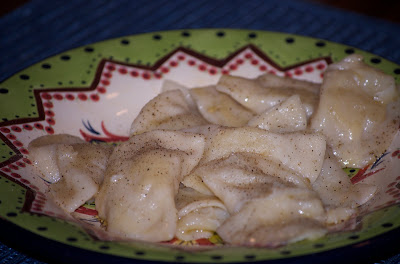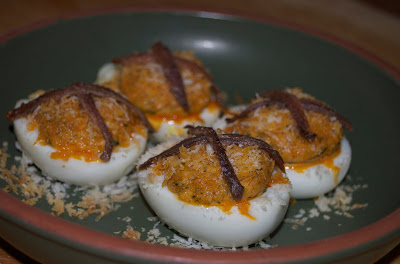In my search for international cuisines around Los Angeles, I look for mom-n-pop style restaurants, where I know I’ll find authenticity and warmth. But as I focus my spotlight on Russian cuisine, I’ve made an interesting discovery: the mom-n-pops are difficult to find. In fact, it was explained to me that Russians tend to eat at home and that dining out is reserved for special occasions. And for a special occasion, you can expect to drop some major bucks.
Finally I discovered Kalinka, a Russian teahouse in Encino, that serves breakfast and lunch as well as dinner. Affordably. I also wanted to step back from the Armenian influence and focus more on those regions further north. Kalinka fit the bill on this score as well, so I popped in for lunch.
I started with Olivye Salad, a tremendously popular Russian-style potato salad that includes green peas, green beans, onions, pickles, hard-boiled eggs and sour cream. This refined version of potato salad was created by a chef by the name of Olivier who jealously guarded his secret recipe, even taking it to the grave with him. However, it seems enough people nosed around the kitchen while he was making it that it has been endlessly analyzed, copied and tweaked over the years. The dainty macédoine cut gives it a more refined look than your average potato salad filled with chunks of this and that in varying sizes. In fact, eating it made me want to drink something in a stemmed glass.
The beverage of the day was Kvas, which is sort of a near-beer kind of thing that doesn’t belong in stemware. It tastes like a partially flat beer with almost no alcohol, about one percent. It is made through a fermentation process involving rye bread, and in addition to being a beverage, kvas is often used for cooking. I didn’t care for it much, but I’m betting it’s one of those things that if you drank it often, you’d develop a taste for it. And it’s easy enough to make at home, so you can tweak it to suit your individual taste.
My entrée was blinchiki, a crepe that’s filled with cooked ground meat (mine was chicken) and then fried. It was good, in a hearty, basic sort of way, but I wish I’d noticed that for a couple of dollars more I could have gotten it with sour cream and red caviar. The further you move from the equator, the more mildly your food is seasoned. I know this, but still I yearn for something zingier or at least a little more complex.
Since dining at home is the norm, I figured I’d best do the same. I crossed Ventura Boulevard and checked out Rasputin Market to see what I could discover. Hearty breads, meats and lots of pickled herring–lots of pickled everything, in fact.
I picked up a package of frozen pelmeni filled with potato and onion. They cook up just like any dumpling from any other country, whether it’s freshly or frozen–boil and then sauté in butter. I’ve seen pelmeni referred to as Siberian ravioli, but this truly is one of those foods that you can find almost anywhere on the planet. Only the fillings and sauces change.
Deviled eggs seem to be popular throughout Russia, for I found several different regional recipes for them. Jajka Minsky, or Minsk-style eggs, are popular at Christmas and Easter in particular. Cream the yolks together with butter, mayo and heavy cream, and mix in chopped dill and parsley, along with paprika, salt and pepper–and some finely chopped egg whites, which I pressed through a mesh strainer for a super-fine texture. I piped them into the egg white halves, then topped them with a mixture of bread crumbs and grated Gruyere and an X of anchovies sliced long ways. They go into the oven for a few minutes, just to warm them up and toast the tops. Sheer decadence!
All of the “borscht belt” references I’ve heard over the years made me assume that borscht was strictly a kosher item. But then I found a Ukrainian borscht recipe that calls for pork sausage… porcht? I made an enormous pot of it and froze the bulk in pint-sized containers. It’s really fine stuff, rich and flavorful:
Crumble a pound of sausage into a large skillet and cook, stirring until the pink is gone. Drain, blot and set aside. Bring two quarts of water to a boil in a really large pot (you’ll be adding in a lot of food, and you’ll need to be able to stir it), add four peeled and shredded beets and cook for about 20 minutes. Then add three peeled and shredded carrots and three medium baking potatoes, peeled and small diced, and cook until the potatoes are tender. Core and chop half a head of cabbage and add that in, along with an 8-oz. can of diced tomatoes, juice and all. While the pot regains its heat and starts to simmer again, put a tablespoon of vegetable oil into a medium skillet and sauté one medium onion, diced, until tender. Stir in a 6-oz. can of tomato paste and about a cup of water with the onion and mix well. Add this mixture to the pot, along with three minced cloves of garlic, and kill the heat. Let the pot stand for about five minutes–the ambient heat will cook the garlic. Add salt and black pepper to taste, and serve it up with a dollop of sour cream.
What would a Russian entry be without mentioning vodka? I found a recipe for honey vodka, which is popular in the Baltic States, particularly in Lithuania. It’s akin to mead, except that it’s far stronger than any honeyed wine, with more flavorings–this version has vanilla bean, nutmeg, lemon peel, cinnamon, cloves and honey. I’ve never been able to endure a medicinal hot toddy–and I’ve always preferred gin to vodka–but this I can certainly sip and enjoy. And after a hearty Russian meal, this makes a good combination dessert and digestiv. Or maybe one glass for dessert and another for digestiv.
And then we sleep!



















